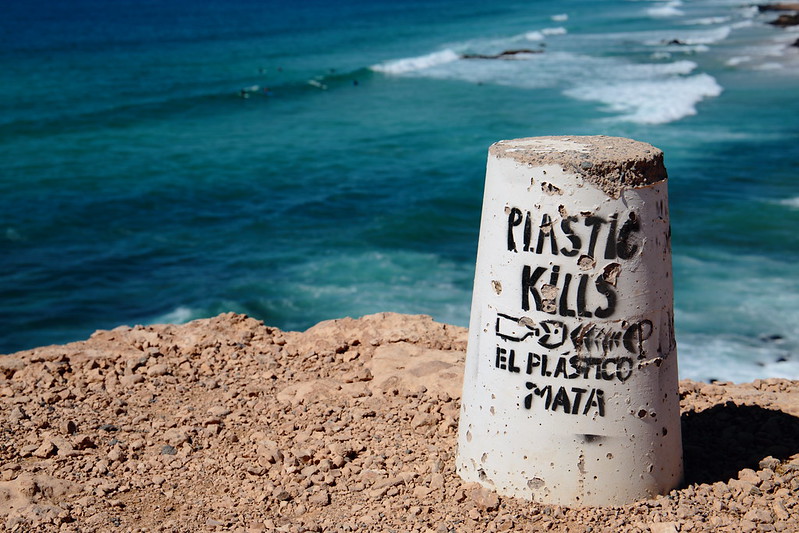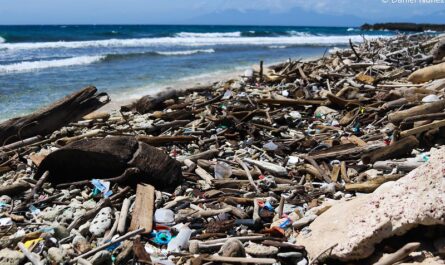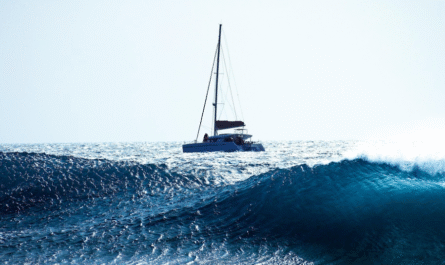Plastic pollution has become one of the most pressing environmental challenges of our time, with the Atlantic Ocean serving as both a victim and a carrier of this global crisis. Every year, millions of tons of plastic waste enter the ocean, breaking down into smaller particles known as microplastics. These tiny fragments are now pervasive throughout the Atlantic, from surface waters to deep-sea sediments, and they are infiltrating the marine food chain with alarming consequences for marine life and human health.
This article explores how microplastics are entering the Atlantic Ocean’s food chain, their impact on ecosystems, and the urgent need for solutions to address this growing problem.
The Scale of Plastic Pollution in the Atlantic
The Atlantic Ocean receives an estimated 17 million tons of plastic annually, much of which originates from coastal populations, rivers, and shipping routes. Plastics in the ocean degrade over time due to sunlight, wave action, and microbial activity, breaking into smaller fragments less than 5 millimeters in size—microplastics.
Sources of Plastic Pollution
- Land-Based Sources: Coastal cities, rivers, and stormwater runoff carry plastic waste directly into the ocean.
- Fishing and Shipping: Lost or discarded fishing gear, known as “ghost nets,” and shipping debris contribute significantly to ocean plastics.
- Atmospheric Deposition: Microplastics have been found in rainfall, meaning they can enter the ocean from the atmosphere.
Microplastics in the Atlantic
Recent studies have found microplastics at every depth of the Atlantic, from surface waters to sediments thousands of meters below. These particles are made of materials like polyethylene, polypropylene, and polystyrene, commonly used in packaging, textiles, and consumer goods.
How Microplastics Enter the Food Chain
Microplastics infiltrate the food chain at every level, from the smallest plankton to the largest predators. This infiltration occurs through various pathways:
1. Plankton and Filter Feeders
Plankton, the foundation of the marine food web, inadvertently consume microplastics that resemble their natural food. These microplastics are then passed up the food chain as predators feed on plankton.
- Impact on Plankton: Consuming microplastics can reduce plankton’s energy reserves and impair reproduction, threatening the base of the marine ecosystem.
- Filter Feeders: Animals like mussels, oysters, and baleen whales are especially vulnerable, as they filter large volumes of water and unintentionally ingest microplastics.
2. Fish and Shellfish
Microplastics are mistaken for food by fish and shellfish, accumulating in their stomachs and tissues.
- Internal Blockages: Ingested microplastics can block digestive tracts, reducing the ability of fish to absorb nutrients.
- Bioaccumulation: Persistent microplastics accumulate in the tissues of fish, which are then consumed by larger predators or humans.
3. Top Predators
Larger marine animals, such as sharks, dolphins, and seabirds, consume prey contaminated with microplastics. This leads to biomagnification, where microplastics and their associated toxins become more concentrated at higher levels of the food chain.
- Seabirds: Many seabird species ingest microplastics, mistaking them for fish or other prey. This ingestion often leads to starvation as plastics fill their stomachs without providing nutrition.
- Marine Mammals: Dolphins and seals have been found with microplastics in their stomachs, highlighting the widespread reach of this pollution.
Impacts of Microplastics on Marine Ecosystems
The infiltration of microplastics into the food chain has wide-ranging implications for marine ecosystems:
1. Physical Harm
Microplastics can cause physical harm to marine organisms, including internal injuries, blockages, and reduced feeding efficiency.
2. Chemical Pollution
Plastics often contain harmful additives, such as bisphenol A (BPA) and phthalates, which can leach into organisms upon ingestion. Additionally, microplastics act as sponges for environmental toxins like PCBs and pesticides, which are introduced into the food chain.
3. Disruption of Ecosystem Functions
The impacts on plankton, filter feeders, and fish populations can ripple throughout the ecosystem, disrupting predator-prey relationships and ecosystem stability.
Microplastics and Human Health
The contamination of seafood with microplastics has raised concerns about human health. People who consume seafood are likely ingesting microplastics, along with the harmful chemicals they carry.
- Toxicity Risks: The chemicals associated with microplastics, such as endocrine disruptors and carcinogens, can pose long-term health risks.
- Bioaccumulation: Microplastics can accumulate in human tissues over time, although the full extent of their health effects is not yet fully understood.
Addressing Plastic Pollution in the Atlantic
Efforts to reduce microplastic pollution in the Atlantic require a multi-faceted approach, involving governments, industries, and individuals.
1. Policy Interventions
Governments and international organizations are implementing policies to reduce plastic waste and prevent it from reaching the ocean.
- Bans on Single-Use Plastics: Many countries have banned or restricted items like plastic bags, straws, and cutlery to reduce plastic waste.
- Extended Producer Responsibility (EPR): Policies that hold manufacturers accountable for the lifecycle of their products encourage sustainable design and recycling.
2. Clean-Up Initiatives
Numerous organizations are working to remove plastics from the ocean and prevent further pollution.
- The Ocean Cleanup Project: This initiative focuses on removing plastic waste from ocean gyres, including the North Atlantic Garbage Patch.
- Coastal Clean-Ups: Local efforts to clean beaches and riverbanks prevent plastics from entering the ocean.
3. Innovative Technologies
Innovations in materials science and waste management offer new solutions to plastic pollution.
- Biodegradable Plastics: Developing plastics that break down naturally could reduce long-term pollution.
- Microplastic Filters: Advanced filtration systems for wastewater treatment plants can capture microplastics before they enter waterways.
4. Public Awareness and Behavior Change
Educating the public about the impact of plastic pollution can drive changes in consumer behavior and waste management practices.
- Reduce, Reuse, Recycle: Encouraging individuals to minimize plastic use and recycle responsibly reduces the flow of plastic waste.
- Consumer Choices: Supporting businesses that use sustainable packaging and products can create market demand for eco-friendly alternatives.
Conclusion: A Call to Action
The pervasive presence of microplastics in the Atlantic Ocean is a stark reminder of humanity’s impact on the planet. As these tiny pollutants infiltrate the marine food chain, they threaten the health of marine ecosystems and the well-being of humans who depend on the ocean for food and livelihoods.
Addressing plastic pollution requires global cooperation, innovative solutions, and a commitment to reducing plastic waste at its source. By protecting the Atlantic and its inhabitants from the growing crisis of microplastics, we can ensure a healthier future for our oceans and the countless species, including humans, that rely on them.



